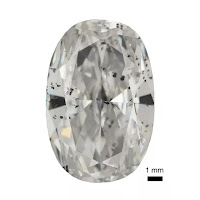
In January 1905, at the Premier Mine in northeastern South Africa, a mine superintendent named Frederick Wells discovered a diamond. It was not unusual to discover diamonds in the mine. But this particular gem was huge: Uncut at 3,106 carats or 1.3 pounds (approximately 621 grams), the crystal was so large, the story goes, that Wells at first believed other miners had buried a hunk (a large thick piece) of glass in the mine as a prank (a trick that is intended to befunny but not to cause harm or damage).
The gemstone was genuine. It would come to bear the
name of the mine’s owner, Sir Thomas Cullinan, who mailed it to London
(costing, Century
Magazine noted in 1909, $1 in postage
while insured at a value of $1.25 million). There, the government of the South
African colony Transvaal presented it to British monarch King Edward VII for
his birthday. Jewelers carved (to cut thin pieces from a large piece) the Cullinan diamond into nine principal stones —
the largest two remain among the Crown Jewels — and dozens of smaller gems.
Most diamonds, of course, do not weigh almost as
much as a regulation NBA basketball. But a very few of the carbon
crystals, which have earned names such as the Cullinan, the Constellation
diamond and the Koh-i-Noor, are far
larger than the average engagement gem.
To geochemists like Evan M. Smith, at the Gemological
Institute of America in New York, the stones have more than monetary worth (considered to be of a value which is equal to or more than expended money for it) or
pretty sparkles (energetic, interesting and exciting). The material, and its imperfections (containing damages or problems) , are valuable. Diamonds
are hardened capsules of chemical information, containing insights into forces
hundreds of miles below the earth. As Smith told NPR, “Diamond is the ultimate (most extreme or important) Tupperware (a container for storage).”
Smith and his colleagues at American, Italian and
South African research institutions recently published an examination of these
stones in the journal Science. The typical diamond formed about 100 miles beneath
the surface, where pressure squeezed pockets of carbon atoms into precious
crystals. The giant diamonds, the new research suggests, were birthed in liquid
metal pools even deeper below.
For chemical analysis, the scientists collected a
handful of offcuts — the scraps and shavings that result from crafting jewels —
from some of the largest diamonds. Such diamonds, like the Cullinan, have
little nitrogen (chemical element with atomic number 7) content. They tend to be lumpy (a piece of solid substance) or irregular in shape and have
very few of the flaws called inclusions.
But these diamonds are not
completely perfect. Thanks to an analysis of the inclusions within the
offcuts, as well as an inspection of 53 Type II diamonds (they contain little or no nitrogen) The scientists also detected “a thin fluid jacket” of
methane, the authors wrote in the study, that surrounded the inclusions like a
film. Fifteen of the diamonds, too, had traces of the mineral garnet (hard, dark red stone, гранат).
Taking all of the chemical clues together, the inclusions suggested the existence of liquid metal pockets in Earth’s rocky mantle between 240 and 460 miles below the surface. (Garnet is unstable beyond 466 miles beneath the surface, the scientists noted.) That is as far below our feet as satellites in low Earth orbit, NPR noted, are
above our heads; the Kola Superdeep Borehole (is the result of scientific drilling project of the Soviet Union in the Pechengsky District, on the Kola Peninsula), the world’s deepest human-made hole, goes down 7,5 miles beneath Russian soil.After the diamonds crystallized out of the liquid metal, shafts of erupting rock called kimberlite propelled the gems to the surface. The kimberlite pipes may have traveled violently, thrust (to push suddenly and strongly) upward at speeds of 30 miles an hour, National Museum of Natural History geologist Jeffrey E.Post told Smithsonian Magazine in 2006. “Once the diamonds are brought to the surface and cooled relatively quickly, those carbon atoms are locked into place,” he said, preventing the atoms from forming graphite, another all-carbon structure.
Earlier experiments hinted at metallic iron in the
deep mantle. Smith, in a news release called the Type II diamond inclusions “consistent,
systematic physical evidence to support this prediction.”
Researchers are examining inclusions in
billions-year-old diamonds to learn not just about the deep Earth but
also the planet’s ancient history. Steven Shirey, a co-author of the recent study and a geochemist at
the Carnegie Institution for Science, said in a 2011 study release that diamond imperfections can “provide age and
chemical information for a span of more than 3.5 billion years that includes
the evolution of the atmosphere, the growth of the continental crust, and the
beginning of plate tectonics.”

Комментариев нет:
Отправить комментарий